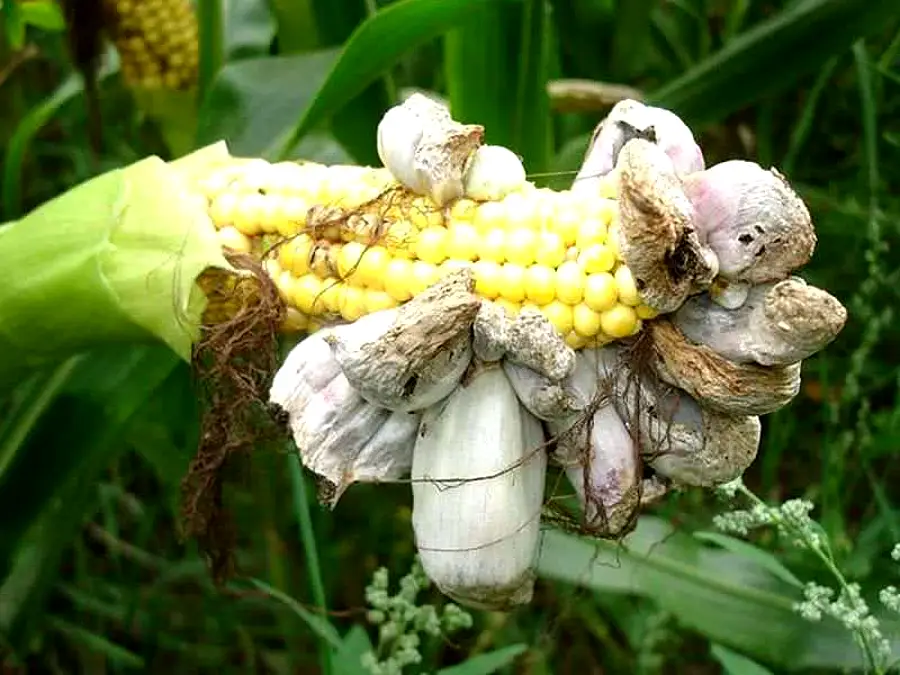Contents
CLASSIFICATION OF USTILAGO (SMUTS)
Kingdom :- Mycota
Division :- Eumycota
Sub-division :- Basidiomycotina
Class :- Teliomycetes
Order :- Ustilaginales
Family :- Ustilaginaceae
Genus :- Ustilago
The fungus Ustilago parasitizes mostly the cultivated grasses as wheat, barley, oat, sugarcane, etc. grown in crop fields. Cynodon dactylon, another host, occurs wild in shades, also as a weed on boundaries of fields and is very common grass in lawns.
STUDY OF HOSTS, DISEASES AND THE SYMPTOMS
Various species of Ustilago are parasitic in their natural habitat but many of them grow as saprophytes also. Most of the species infect members of the grass family (Poaceae) and cause enonnous loss. The cereal smuts are classified into loose smut and covered smut. Both are seed borne types.
-
- In loose smut, the spores occur in the grains which are exposed only on maturity of the ear and are easily blown away by wind (infection air borne).
- In the covered smut, spore masses remain covered by the wall of grain and glumes (not exposed). These are liberated when wall is ruptured under pressure (infection seed borne). Only the inflorescences are attacked in all the cases. The disease, in general, caused by species of Ustilago, on various hosts, is known as smut disease because of production of black dusty mass of spores. The following are common hosts and diseases.
- tritici infects wheat (Triticum vulgare; vern. gehun) and causes loose smut of wheat.
- nuda and U.hordei infect barley (Hordeum vulgare; vern. jau) and cause loose smut and covered smut of barley, respectively.
- avenae and U. kolleri infect oat (Avena sativa; vern. jaii) and cause loose smut and covered smut respectively. In covered and loose smuts of various cereals, the symptoms are seen only at the time of flowering and not before. The grains in the inflorescence of the hosts are replaced by black and sooty mass of teliospores. The infected plants produce defonned spikelets. As the grain is directly affected, the yield of the crop is considerably reduced.
- scitaminea attacks sugarcane (Saccharum officinarum; vern. ganna) causing whip smut of sugarcane. The whip smut of sugarcane causes the floral axis of infected plant to become long and whiplike, covered by black sooty spores.
- maydis attacks maize (Zea mays; vern makka) and resuls into a disease called, common smut of maize. In common smut of maize, large galls are produced on the cob which are sometimes as large as man’s fist. These galls partly consist of host tissue and partly of fungus tissue.
- cynodontis infects grass (Cynodon dactylon; vern. doob ghas) and causes loose smut of grass.
- Other species of U stilago infecting economically useful plants include U. panicifrumentacei and U. paradoxa on barnyard millet (Echinocloa Jrumentacea). U. crameri on Italian millet (Setaria italica), and U. coicis and U. lacrymaejobi on job’s tear millet (Coix lacryma-jobi).
- violacea causes another smut of Caryophyllaceae.
STUDY OF VEGETATIVE STRUCTURE
- The mycelium is well developed. It is generally intercellular without haustoria but sometimes, it is intracellular also.
- The mycelium is branched and septate and can be seen only in younger portions.
- The mycelium can be monokaryotic when it has only one nucleus in each cell. It also becomes dikaryotic when it possesses two nuclei of different strains in each cell.
STUDY OF CHLAMYDOSPORES OR TELEUTOSPORES
- The chlamydospores are formed in the grains of the host by repeated partition of the mycelium.
- The mature chlamydospores are black soot-like in colour.
- Each chlamydospore (teliospores) at maturity is unicellular, uninucleate, diploid and globose. The wall is thick with exospore and endospore. Exospore is thick and spiny while endospore is thin and smooth.
- It germinates to form four basidiospores which in their tum produce the monokaryotic (primary) mycelium.
IDENTIFICATION
- KINGDOM – Mycota
- Chlorophyll absent
- Reserve food glycogen
- Cell wall of fungal cellulose.
- DIVISION – Eumycota
- A definite cell wall present.
- SUB-DIVISION:- Basidiomycotina
- Mycelium septate.
- Characteistic reproductive body, basidium.
- Basidiospores usually four, produced exogenously.
- CLASS :- Teliomycetes
- Basidiocarp lacking.
- Teliospores or chlamydospores in sori or scattered.
- Parasitic on vascular plants.
- ORDER – Ustilaginales
- Hyphae inter- as well as intracellular.
- Teleutospores (teliospores) mostly intercalary, basidiospores not on sterigmata.
- FAMILY – Ustilaginaceae
- Chlamydospores formed in the host tissue from the hyphal cells
- GENUS – Ustilago
- Chlamydospores separate and not adhering in pairs.
- Sori dusty at maturity.


Leave a Reply